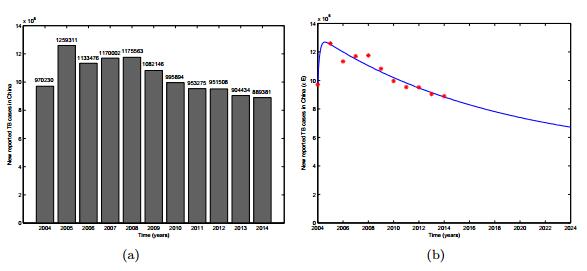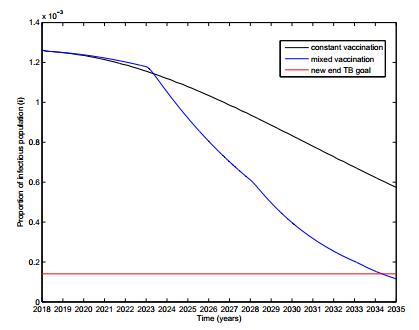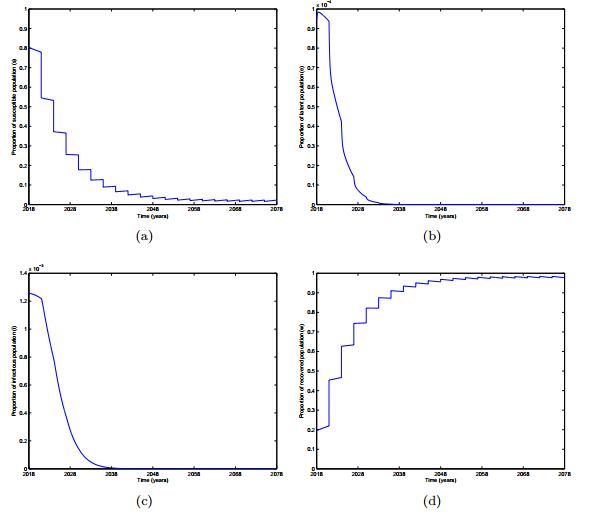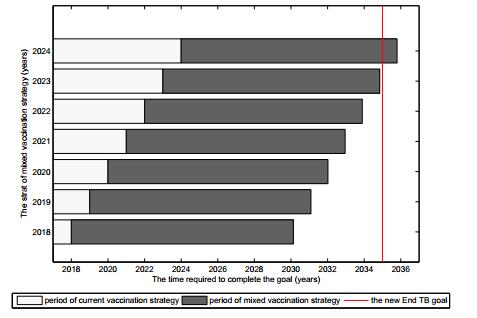This study first presents a mathematical model of TB transmission considering BCG vaccination compartment to investigate the transmission dynamics nowadays. Based on data reported by the National Bureau of Statistics of China, the basic reproduction number is estimated approximately as R0=1.1892. To reach the new End TB goal raised by WHO in 2015, considering the health system in China, we design a mixed vaccination strategy. Theoretical analysis indicates that the infectious population asymptotically tends to zero with the new vaccination strategy which is the combination of constant vaccination and pulse vaccination. We obtain that the control of TB is quicker to achieve with the mixed vaccination. The new strategy can make the best of current constant vaccination, and the periodic routine health examination provides an operable environment for implementing pulse vaccination in China. Numerical simulations are provided to illustrate the theoretical results and help to design the final mixed vaccination strategy once the new vaccine comes out.
1.
Introduction
The Hermite-Hadamard inequality, which is one of the basic inequalities of inequality theory, has many applications in statistics and optimization theory, as well as providing estimates about the mean value of convex functions.
Assume that f:I⊆R→R is a convex mapping defined on the interval I of R where a<b. The following statement;
holds and known as Hermite-Hadamard inequality. Both inequalities hold in the reversed direction if f is concave.
The concept of convex function, which is used in many classical and analytical inequalities, especially the Hermite-Hadamard inequality, has attracted the attention of many researchers see [4,7,8,9], and has expanded its application area with the construction of new convex function classes. The introduction of this useful class of functions for functions of two variables gave a new direction to convex analysis. In this sense, in [6], Dragomir mentioned about an expansion of the concept of convex function, which is used in many inequalities in theory and has applications in different fields of applied sciences and convex programming.
Definition 1.1. Let us consider the bidimensional interval Δ=[a,b]×[c,d] in R2 with a<b,c<d. A function f:Δ→R will be called convex on the co-ordinates if the partial mappings fy:[a,b]→R,fy(u)=f(u,y) and fx:[c,d]→R,fx(v)=f(x,v) are convex where defined for all y∈[c,d] and x∈[a,b]. Recall that the mapping f:Δ→R is convex on Δ if the following inequality holds,
for all (x,y),(z,w)∈Δ and λ∈[0,1].
Transferring the concept of convex function to coordinates inspired the presentation of Hermite-Hadamard inequality in coordinates and Dragomir proved this inequality as follows.
Theorem 1.1. (See [6]) Suppose that f:Δ=[a,b]×[c,d]→R is convex on the co-ordinates on Δ. Then one has the inequalities;
The above inequalities are sharp.
To provide further information about convexity and inequalities that have been established on the coordinates, see the papers [1,2,5,10,11,12,13,14,15]).
One of the trending problems of recent times is to present different types of convex functions and to derive new inequalities for these function classes. Now we will continue by remembering the concept of n-polynomial convex function.
Definition 1.2. (See [16]) Let n∈N. A non-negative function f:I⊂R→R is called n-polynomial convex function if for every x,y∈I and t∈[0,1],
We will denote by POLC(I) the class of all n-polynomial convex functions on interval I.
In the same paper, the authors have proved some new Hadamard type inequalities, we will mention the following one:
Theorem 1.2. (See [16]) Let f:[a,b]→R be an n-polynomial convex function. If a<b and f∈L[a,b], then the following Hermite-Hadaamrd type inequalities hold:
Since some of the convex function classes can be described on the basis of means, averages have an important place in convex function theory. In [3], Awan et al. gave the harmonic version on the n-polynomial convexity described on the basis of the arithmetic mean as follows. They have also proved several new integral inequalities of Hadamard type.
Definition 1.3. (See [3]) Let n∈N and H⊆(0,∞) be an interval. Then a nonnegative real-valued function f:H→[0,∞) is said to be an n-polynomial harmonically convex function if
for all x,y∈H and t∈[0,1].
Theorem 1.3. (See [3]) Let f:[a,b]⊆(0,∞)→[0,∞) be an n-polynomial harmonically convex function. Then one has
if f∈L[a,b].
The main motivation in this study is to give a new modification of (m,n)-harmonically polynomial convex functions on the coordinates and to obtain Hadamard type inequalities via double integrals and by using Hö lder inequality along with a few properties of this new class of functions.
2.
Main results
In this section, we will give a new classes of convexity that will be called (m,n)-polynomial convex function as following.
Definition 2.1. Let m,n∈N and Δ=[a,b]×[c,d] be a bidimensional interval. Then a non-negative real-valued function f:Δ→R is said to be (m,n)-harmonically polynomial convex function on Δ on the co-ordinates if the following inequality holds:
where (x,y),(x,w),(z,y),(z,w)∈Δ and t,s∈[0,1].
Remark 2.1. If one choose m=n=1, it is easy to see that the definition of (m,n)-harmonically polynomial convex functions reduces to the class of the harmonically convex functions.
Remark 2.2. The (2,2)-harmonically polynomial convex functions satisfy the following inequality;
where (x,y),(x,w),(z,y),(z,w)∈Δ and t,s∈[0,1].
Theorem 2.1. Assume that b>a>0,d>c>0,fα:[a,b]×[c,d]→[0,∞) be a family of the (m,n)-harmonically polynomial convex functions on Δ and f(u,v)=supfα(u,v). Then, f is (m,n)- harmonically polynomial convex function on the coordinates if K={x,y∈[a,b]×[c,d]:f(x,y)<∞} is an interval.
Proof. For t,s∈[0,1] and (x,y),(x,w),(z,y),(z,w)∈Δ, we can write
which completes the proof.
Lemma 2.1. Every (m,n)-harmonically polynomial convex function on Δ is (m,n)-harmonically polynomial convex function on the co-ordinates.
Proof. Consider the function f:Δ→R is (m,n)-harmonically polynomial convex function on Δ. Then, the partial mapping fx:[c,d]→R,fx(v)=f(x,v) is valid. We can write
for all t∈[0,1] and v,w∈[c,d]. This shows the (m,n)-harmonically polynomial convexity of fx. By a similar argument, one can see the (m,n)-harmonically polynomial convexity of fy.
Remark 2.3. Every (m,n)-harmonically polynomial convex function on the co-ordinates may not be (m,n)-harmonically polynomial convex function on Δ.
A simple verification of the remark can be seen in the following example.
Example 2.1. Let us consider f:[1,3]×[2,3]→[0,∞), given by f(x,y)=(x−1)(y−2). It is clear that f is harmonically polynomial convex on the coordinates but is not harmonically polynomial convex on [1,3]×[2,3], because if we choose (1,3),(2,3)∈[1,3]×[2,3] and t∈[0,1], we have
Then, it is easy to see that
This shows that f is not harmonically polynomial convex on [1,3]×[2,3].
Now, we will establish associated Hadamard inequality for (m,n)-harmonically polynomial convex functions on the co-ordinates.
Theorem 2.2. Suppose that f:Δ→R is (m,n)-harmonically polynomial convex on the coordinates on Δ. Then, the following inequalities hold:
Proof. Since f is (m,n)-harmonically polynomial convex function on the co-ordinates, it follows that the mapping hx and hy are (m,n)-harmonically polynomial convex functions. Therefore, by using the inequality (1.3) for the partial mappings, we can write
namely
Dividing both sides of (2.2) by (b−a)ab and by integrating the resulting inequality over [a,b], we have
By a similar argument for (2.3), but now for dividing both sides by (d−c)cd and integrating over [c,d] and by using the mapping hy is (m,n)-harmonically polynomial convex function, we get
By summing the inequalities (2.4) and (2.5) side by side, we obtain the second and third inequalities of (2.1). By the inequality (1.3), we also have:
and
which give by addition the first inequality of (2.1). Finally, by using the inequality (1.3), we obtain
and
which give by addition the last inequality of (2.1).
In order to prove our main findings, we need the following identity.
Lemma 2.2. Assume that f:Δ=[a,b]×[c,d]⊂(0,∞)×(0,∞)→R be a partial differentiable mapping on Δ and ∂2f∂t∂s∈L(Δ). Then, one has the following equality:
where At=tb+(1−t)a,Bs=sd+(1−s)c.
Theorem 2.3. Let f:Δ=[a,b]×[c,d]⊂(0,∞)×(0,∞)→R be a partial differentiable mapping on Δ and ∂2f∂t∂s∈L(Δ). If |∂2f∂t∂s|q is (m,n)-harmonically polynomial convex function on Δ, then one has the following inequality:
where
and At=tb+(1−t)a,Bs=sd+(1−s)c for fixed t,s∈[0,1],p,q>1 and p−1+q−1=1.
Proof. By using the identity that is given in Lemma 2.2, we can write
By using the well known Hölder inequality for double integrals and by taking into account the definition of (m,n)-harmonically polynomial convex functions, we get
By computing the above integrals, we can easily see the followings
and
where 2F1 is Hypergeometric function defined by
for c>b>0,|z|<1 and Beta function is defind as B(x,y)=1∫0tx−1(1−t)y−1dt,x,y>0. This completes the proof.
Corollary 2.1. If we set m=n=1 in (2.6), we have the following new inequality.
where
Corollary 2.2. Suppose that all the conditions of Theorem 2.3 hold. If we set |∂2f(t,s)∂t∂s|q is bounded, i.e.,
we get
where c1,c2,c3,c4 as in Theorem 2.3.
3.
Acknowledgements
N. Mlaiki and T. Abdeljawad would like to thank Prince Sultan University for funding this work through research group Nonlinear Analysis Methods in Applied Mathematics (NAMAM) group number RG-DES-2017-01-17.
S. Butt would like to thank H. E. C. Pakistan (project 7906) for their support.
Conflict of interest
The authors declare that no conflicts of interest in this paper.

















 DownLoad:
DownLoad: